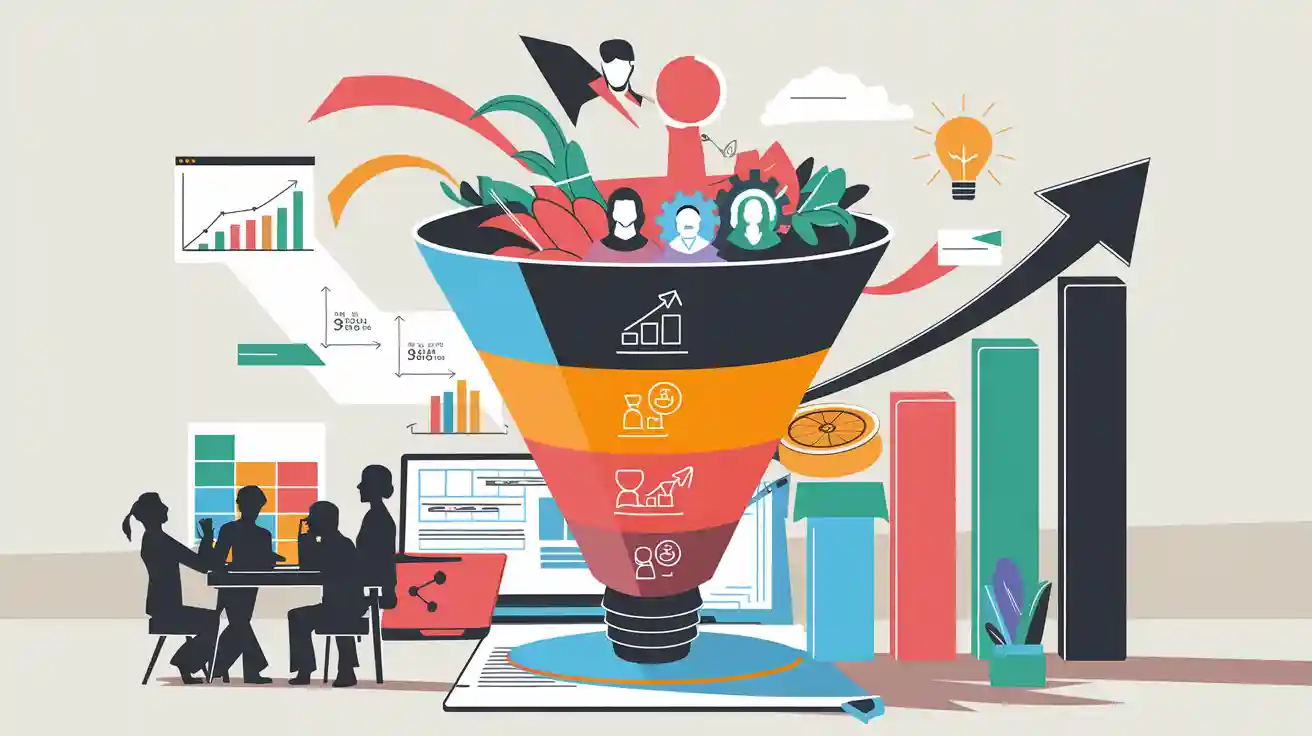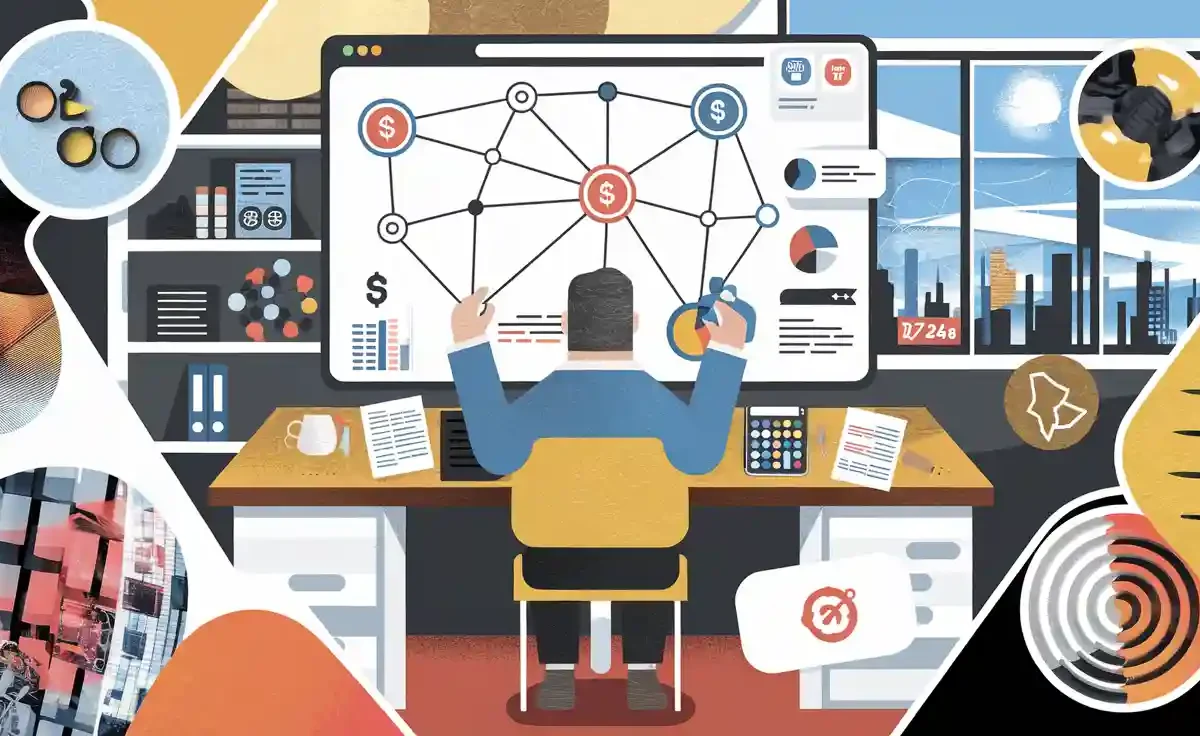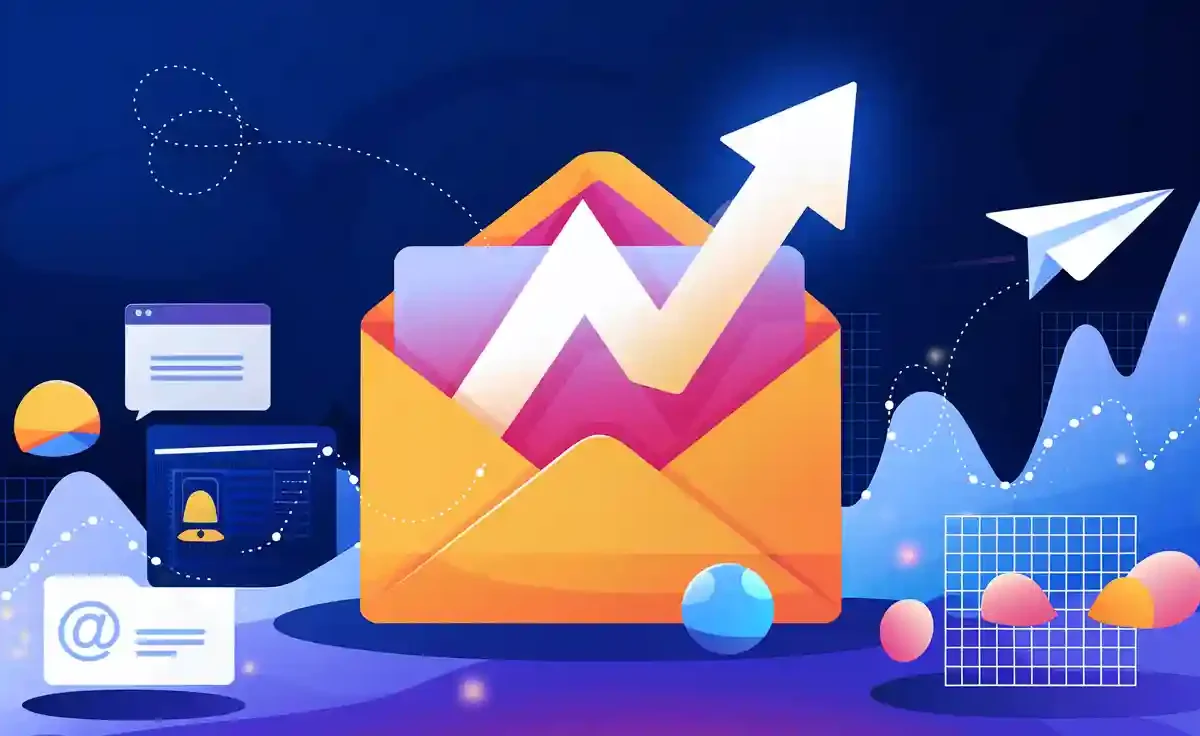
Optimizing your sales funnel is the key to unlocking higher sales conversions and boosting your business growth. Every stage of the funnel, from awareness to retention, presents opportunities to refine your approach and increase conversion rates. For instance, landing pages that convert often include videos, which improve performance by 86%. Personalized email campaigns can also increase open rates by 29% and click-through rates by 41%. These strategies not only enhance website conversion rates but also nurture leads effectively, leading to larger purchases and shorter sales cycles.
To optimize your sales funnel successfully, you must test it regularly and implement a strong call to action. By taking deliberate action, you can transform drop-offs into opportunities and create a seamless journey for your customers.
Key Takeaways
Know who your audience is to plan better marketing. Meeting their needs helps you get more sales.
Make good, helpful content that people enjoy. This earns trust and keeps customers coming back.
Use social media to talk to your audience. Pick the best platforms and post often to get more sales.
Make your website load quickly and easy to use. Clear buttons and fast pages make customers happy and buy more.
Offer free stuff to get emails from people. This grows your email list and helps turn leads into buyers.
1. Define Your Target Audience
Understanding your target audience is the foundation of effective sales funnel optimization. Without a clear picture of who your ideal customer is, your marketing efforts can feel like shooting arrows in the dark. By defining your audience, you can create tailored strategies that convert customers and maximize your conversion funnel’s potential.
Understand Your Ideal Customer
Start by identifying the characteristics of your ideal customer. Think about their demographics, interests, and behaviors. What challenges do they face? What solutions are they actively seeking? Answering these questions helps you align your marketing efforts with their needs.
Tip: Segmentation is a powerful way to organize consumers into groups with similar needs. This approach enhances personalization, leading to better engagement and higher-quality leads.
Focused marketing not only saves resources but also boosts effectiveness. For example:
Evidence | Description |
|---|---|
Focused marketing budget | Narrowing your marketing focus creates more effective marketing, reducing waste on uninterested audiences. |
Better leads | Targeting the right audience results in higher-quality leads and increased sales due to reaching those with the need and ability to purchase. |
Create Detailed Buyer Personas
Once you understand your ideal customer, take it a step further by creating detailed buyer personas. These personas are fictional representations of your audience segments, based on real data and insights. Include specifics like age, occupation, income level, and preferred communication channels.
Buyer personas allow you to craft personalized experiences that resonate deeply with your audience. Personalization can increase revenue by up to 760 percent, making it one of the most impactful ways to optimize your sales funnel.
Action Step: Use tools like surveys or analytics to gather data about your audience. Then, translate this information into actionable buyer personas that guide your marketing strategies.
When you know your audience inside and out, you can design pages, calls to action, and campaigns that speak directly to their needs. This clarity transforms your conversion funnel into a streamlined path that leads to higher sales and stronger customer relationships.
2. Create High-Quality Content
Creating high-quality content is one of the most effective ways to optimize your sales funnel. It helps you attract qualified leads, engage your audience, and convert customers at every stage of the funnel. By focusing on educational and engaging content and leveraging SEO, you can boost conversion rates and build lasting relationships with your audience.
Focus on Educational and Engaging Content
Your content should provide value to your audience. Educational content positions you as an authority in your industry, while engaging content keeps your audience interested and coming back for more. This combination builds trust and encourages action.
Here are some tips to make your content stand out:
Answer common questions: Address the pain points your audience faces. Offer actionable solutions that guide them toward your product or service.
Use storytelling: Share relatable stories that connect emotionally with your audience. Stories make your message memorable and impactful.
Incorporate visuals: Use images, videos, and infographics to make your content more engaging. Visuals can increase retention rates and improve the overall user experience.
High-quality content doesn’t just attract new visitors. It also retains existing customers. Businesses that focus on customer satisfaction could save over $35 billion annually. Repeat customers spend 67% more than new ones, making retention a key part of your sales funnel strategy.
Use SEO to Attract Organic Traffic
Search engine optimization (SEO) ensures your content reaches the right audience. By optimizing your pages for search engines, you can drive organic traffic and generate qualified leads.
Follow these SEO best practices:
Target relevant keywords: Research keywords your audience searches for. Use them naturally in your headlines, subheadings, and body text.
Optimize meta descriptions: Write compelling meta descriptions that include a call to action. These snippets encourage users to click on your pages.
Improve page speed: Ensure your pages load quickly. Slow-loading pages can hurt your rankings and drive potential leads away.
SEO not only improves visibility but also enhances customer retention. Companies improving customer experience through SEO see an 84% increase in revenue. By combining SEO with high-quality content, you create an irresistible offer that keeps your audience engaged and loyal.
Pro Tip: Monitor metrics like repeat purchase rate and customer retention rate to measure the impact of your content. Higher retention rates reflect successful engagement and a well-optimized sales funnel.
3. Leverage Social Media Marketing

Social media marketing is a powerful tool for driving conversions and enhancing your sales funnel. By choosing the right platforms and engaging consistently, you can connect with your audience, build trust, and guide them toward taking action.
Choose the Right Platforms for Your Audience
Not all social media platforms are created equal. Each platform attracts a unique audience with specific preferences. To maximize conversions, focus on the platforms where your target audience spends the most time. For example, LinkedIn works well for B2B businesses, while Instagram excels for visual storytelling and younger demographics.
Start by analyzing your audience’s behavior. Use tools like Google Analytics or social media insights to identify which platforms drive the most traffic to your landing pages. Once you know where your audience is, tailor your content to match the platform’s style. Short videos perform well on TikTok, while long-form posts thrive on LinkedIn. This alignment ensures your message resonates and encourages users to explore your sales funnel.
Tip: Test different platforms to see which ones generate the highest engagement and conversions. Focus your efforts on the top performers.
Engage Consistently with Followers
Consistency is key to building relationships on social media. Regular engagement keeps your brand top-of-mind and fosters trust. Respond to comments, answer questions, and participate in conversations. This interaction shows your audience that you value their input.
Create a content calendar to plan posts in advance. Include a mix of educational posts, promotions, and content upgrades like free guides or templates. These upgrades can drive traffic to your landing page and capture leads. Use polls, quizzes, and live videos to encourage participation. The more interactive your content, the higher your chances of driving conversions.
Pro Tip: Use analytics to track which posts lead to the most clicks and conversions. Double down on strategies that work and refine those that don’t.
By leveraging social media effectively, you can turn casual followers into loyal customers. This approach strengthens your sales funnel and boosts your overall performance.
4. Optimize Your Website for Conversions
Your website is the backbone of your sales funnel. A well-optimized site can turn casual visitors into loyal customers. By focusing on fast loading speeds and clear calls-to-action, you can create a seamless experience that drives conversions.
Ensure Fast Loading Speeds
Speed matters. Visitors expect pages to load instantly. A delay of even one second can cause users to abandon your site. Slow-loading pages frustrate potential customers and hurt your sales funnel optimization efforts.
To improve loading speeds:
Compress images: Large image files slow down your site. Use tools to reduce file sizes without sacrificing quality.
Minimize code: Remove unnecessary code and scripts to streamline your site’s performance.
Use a reliable hosting provider: Choose a host that offers fast servers and minimal downtime.
Fast-loading pages enhance usability and keep visitors engaged. They also improve your search engine rankings, making it easier for potential customers to find your site. A quick-loading landing page can make the difference between a bounce and a conversion.
Use Clear Calls-to-Action
A clear call-to-action (CTA) guides visitors toward the next step. Without it, users may leave your site without taking action. Effective CTAs are simple, direct, and visually appealing.
Here’s how to create CTAs that convert:
Use action-oriented language: Phrases like “Get Started” or “Claim Your Free Trial” motivate users to act.
Make it stand out: Use contrasting colors and bold fonts to draw attention to your CTA.
Place it strategically: Position CTAs above the fold or near key content to maximize visibility.
A strong CTA removes confusion and encourages users to move through your sales funnel. Pair it with trust signals like testimonials or reviews to boost credibility and increase conversions.
By optimizing your website for conversions, you create a user-friendly experience that keeps visitors engaged and drives results. A fast, well-designed site with clear CTAs ensures your sales funnel performs at its best.
5. Use Lead Magnets to Capture Emails
Lead magnets are one of the most effective tools for capturing emails and fueling your email marketing strategy. By offering valuable resources and optimizing your pages, you can encourage visitors to share their contact information and enter your sales funnel.
Offer Free Resources (eBooks, Guides, etc.)
People love free, high-value content. Offering resources like eBooks, guides, or templates can motivate visitors to provide their email addresses. These resources should solve a specific problem or answer a pressing question your audience has. When you deliver value upfront, you build trust and position yourself as an authority in your field.
Tailored lead magnets can increase engagement rates by up to 29%. For example, a well-researched eBook can boost conversion rates by as much as 300%. Free trials or webinars can also enhance conversion rates by up to 40%. These numbers highlight the power of offering something meaningful in exchange for an email address.
Tip: Create resources that align with your audience’s needs. A targeted approach ensures your lead magnet resonates and drives results.
Use Pop-Ups and Landing Pages Effectively
Pop-ups and landing pages are essential for showcasing your lead magnets. A well-designed landing page can guide visitors toward taking action. Use a clear headline, concise copy, and a strong call-to-action to make your offer irresistible. Ensure the page focuses solely on the lead magnet to avoid distractions.
Pop-ups, when used strategically, can also capture attention. Time them to appear after a visitor has spent a few seconds on your site or scrolled halfway down a page. This approach minimizes disruption while maximizing conversions. Audience segmentation can boost engagement by 70%, so consider tailoring your pop-ups to different user groups for better results.
Pro Tip: Test different designs and placements for your pop-ups and landing pages. Small tweaks can lead to significant improvements in your sales funnel optimization.
By combining valuable resources with effective pop-ups and landing pages, you can supercharge your email marketing efforts. These strategies not only capture emails but also nurture leads, driving them further down your sales funnel.
6. Implement Email Marketing Campaigns
Email marketing campaigns are one of the most cost-effective ways to nurture leads and drive conversions. By personalizing your emails and automating your campaigns, you can create meaningful connections with your audience and guide them through your sales funnel.
Personalize Your Emails
Personalization is the secret to making your emails stand out. Generic messages often get ignored, but personalized emails grab attention and build trust. Start by addressing your recipients by name and tailoring the content to their preferences or past interactions. For example, if a lead downloaded a guide from your landing page, follow up with related resources or offers.
Personalized email campaigns deliver impressive returns. Businesses that invest up to $500 in these campaigns see an average ROI of $31 for every dollar spent. eCommerce companies achieve even higher returns, with $45 earned for every dollar invested. These numbers highlight the power of connecting with your audience on a personal level.
Tip: Use segmentation to group your leads based on behavior, interests, or demographics. This approach ensures your emails resonate with each recipient, increasing engagement and conversions.
Use Automated Drip Campaigns
Automated drip campaigns allow you to nurture leads without constant manual effort. These campaigns send a series of pre-written emails based on specific triggers, such as signing up for a newsletter or abandoning a cart. Drip campaigns keep your brand top-of-mind and guide leads through the sales funnel at their own pace.
The ROI of email marketing speaks for itself. For every $1 spent, marketers receive an average return of $36. Industries like marketing and advertising see even higher returns, with $42 earned per dollar. By automating your campaigns, you can maximize these benefits while saving time and resources.
To set up a successful drip campaign:
Define your goals: Decide what action you want your leads to take, such as scheduling a demo or completing a purchase.
Map out the journey: Plan the sequence of emails, ensuring each one adds value and moves the lead closer to conversion.
Test and optimize: Monitor open rates, click-through rates, and conversions. Adjust your content and timing to improve results.
Automated drip campaigns not only save time but also ensure consistent communication with your leads. This consistency builds trust and increases the likelihood of turning prospects into loyal customers.
7. Nurture Leads with Valuable Content
Nurturing leads with valuable content is essential for moving prospects through your sales funnel. By sharing relatable success stories and addressing pain points, you can build trust and guide leads toward conversion.
Share Case Studies and Testimonials
Case studies and testimonials are powerful tools for building credibility. They show potential customers how your product or service has solved real problems for others. This approach creates a sense of trust and reduces hesitation.
For example, a case study can highlight how a client achieved measurable results using your solution. Include specific details like metrics or timelines to make the story compelling. Testimonials, on the other hand, provide social proof. A satisfied customer’s words can resonate more than any marketing message.
Tip: Place testimonials strategically on your pages, such as your landing page or product pages, to maximize their impact.
Sharing these success stories not only increases engagement but also boosts conversion rates. Leads who feel confident in your brand are more likely to take the next step in the sales funnel.
Provide Solutions to Pain Points
Addressing your audience’s pain points is one of the most effective ways to nurture leads. When you offer solutions to their challenges, you position yourself as a trusted advisor. This builds loyalty and encourages action.
Start by identifying the common problems your audience faces. Then, create content that provides actionable solutions. For instance, blog posts, videos, or guides can demonstrate how your product or service resolves these issues. Tailored content keeps prospects interested and engaged with your brand.
Did You Know? Nurtured leads produce a 20% increase in sales opportunities and tend to make 47% larger purchases. Companies that excel in lead nurturing also report a 23% shorter sales cycle.
By delivering valuable content, you enhance engagement and improve conversion rates. This strategy ensures your sales funnel optimization efforts yield measurable results.
8. Use Retargeting Ads to Re-Engage Visitors
Retargeting ads are a powerful way to bring back visitors who left your site without converting. By targeting users who have already shown interest, you can remind them of your offerings and guide them back into your sales funnel.
Target Abandoned Cart Users
Abandoned carts represent missed opportunities. Retargeting ads allow you to re-engage these users and encourage them to complete their purchases. Show them the exact products they left behind, paired with a compelling offer like free shipping or a discount. This strategy taps into their existing interest and nudges them toward action.
To maximize results, experiment with different approaches:
Use A/B testing to refine your ad visuals and calls to action.
Test the effectiveness of discounts versus other incentives.
Set frequency caps to avoid overwhelming users with repetitive ads.
Retargeting abandoned cart users can significantly boost your return on ad spend (ROAS) and conversion rates. These metrics highlight how effectively your ads re-engage visitors and drive them back to your landing page.
Use Dynamic Ads for Personalized Offers
Dynamic ads take personalization to the next level. These ads automatically display products or services based on a user’s browsing behavior. For example, if a visitor viewed specific product pages, dynamic ads can showcase those items alongside complementary recommendations.
Personalized ads resonate more with users, increasing the likelihood of conversions. To keep your campaigns fresh and engaging:
Rotate and refresh your ad creatives regularly.
Avoid ad fatigue by limiting how often users see the same ad.
Dynamic ads also improve metrics like average order value (AOV). Retargeted customers often spend more when they return, making this strategy essential for effective sales funnel optimization.
Metric | Description |
|---|---|
Return on Ad Spend (ROAS) | Indicates the revenue generated relative to the cost of ads, with high ROAS showing effective re-engagement. |
Conversion Rate | Measures the percentage of users who completed a desired action after clicking on retargeting ads. |
Average Order Value (AOV) | Reflects how much retargeted customers spend on average when they return to make a purchase. |
By leveraging retargeting ads, you can transform lost opportunities into conversions. This strategy strengthens your sales funnel and ensures visitors return to your pages ready to take action.
9. Simplify Your Sales Process
A complicated sales process can frustrate potential customers and drive them away. Simplifying the journey ensures a smoother experience, helping you convert more leads into loyal customers. By reducing friction and offering flexible payment options, you can create a seamless path through your sales funnel.
Reduce Friction in the Buying Journey
Every step in your sales process should feel effortless. When customers encounter unnecessary obstacles, they lose interest and abandon their purchase. To reduce friction, focus on streamlining the buying journey.
Start by analyzing your website. Are there too many steps to complete a purchase? Simplify forms by asking only for essential information. Ensure your navigation is intuitive, so users can find what they need quickly.
Tip: Use heatmaps or analytics tools to identify where users drop off. These insights help you pinpoint and fix problem areas.
Clear communication also plays a key role. Provide detailed product descriptions, transparent pricing, and a visible return policy. When customers feel informed, they’re more likely to trust your brand and complete their purchase.
Offer Multiple Payment Options
Payment flexibility can make or break a sale. Customers have diverse preferences, and limiting their options can lead to lost opportunities. Offering multiple payment methods ensures you cater to everyone.
Include popular options like credit cards, digital wallets (e.g., PayPal, Apple Pay), and even buy-now-pay-later services. These choices make it easier for customers to complete their transactions.
Pro Tip: Highlight secure payment methods to build trust. Displaying security badges reassures customers that their information is safe.
A smooth checkout process also boosts your sales funnel optimization efforts. Fewer abandoned carts mean more completed purchases, driving better results for your campaigns.
By simplifying your sales process, you remove barriers that prevent customers from converting. This approach strengthens your sales funnel and ensures a positive experience for every buyer.
10. Build Trust with Social Proof

Building trust is essential for guiding prospects through your sales funnel. When people trust your brand, they feel confident about making a purchase. Social proof, such as customer reviews and industry certifications, plays a vital role in establishing that trust.
Display Customer Reviews and Ratings
Customer reviews and ratings are powerful tools for influencing purchase decisions. They provide real-world validation of your product or service, showing prospects that others have had positive experiences. In fact:
69% of consumers are more likely to buy from a business when reviews highlight positive experiences.
Websites featuring customer reviews achieve a 67% higher conversion rate than those without.
83% of Americans trust recommendations from friends or relatives when deciding to purchase.
To maximize the impact of reviews, display them prominently on your website. Add them to product pages, landing pages, or even your homepage. Include a mix of written reviews and star ratings to cater to different preferences. Encourage satisfied customers to leave reviews by sending follow-up emails or offering small incentives.
Tip: Respond to reviews, both positive and negative. This shows prospects that you value feedback and are committed to improving their experience.
Highlight Industry Certifications or Awards
Industry certifications and awards signal credibility and expertise. They reassure prospects that your business meets high standards and delivers quality. According to recent studies, 88% of people consider brand trust a key factor in their purchase decisions. Certifications and awards demonstrate transparency, which is crucial for building that trust.
Showcase these achievements on your website and marketing materials. Use badges, logos, or banners to make them stand out. For example, if your product is certified organic or has won a “Best in Industry” award, highlight it near your call-to-action buttons. This transparency signals that you stand behind your offerings and are dedicated to excellence.
Pro Tip: Include a brief explanation of what the certification or award means. This helps prospects understand its significance and builds further trust.
By leveraging customer reviews, ratings, and certifications, you create a trustworthy image that encourages prospects to move forward in your sales funnel. Trust drives conversions, making social proof a critical component of sales funnel optimization.
11. Offer Limited-Time Promotions
Limited-time promotions are a proven way to drive immediate action and boost your sales funnel performance. By creating urgency and leveraging countdown timers, you can motivate customers to act quickly and reduce hesitation.
Create a Sense of Urgency
Urgency compels customers to make faster decisions. When they feel they might miss out, they’re more likely to take action. Limited-time offers, early bird discounts, and flash sales are excellent strategies to create this urgency. For example, offering a 24-hour discount or highlighting low stock levels can push hesitant buyers to complete their purchase.
Here’s how these strategies impact sales:
Strategy | Impact on Sales | Description |
|---|---|---|
Limited-time offers | Drives immediate sales and boosts revenue | Encourages quick purchasing decisions, reducing cart abandonment. |
Early bird discounts | Generates early sales momentum and gauges interest | Rewards quick decision-makers, especially effective for new launches and limited editions. |
Real-time inventory updates | Leverages product scarcity to prompt immediate action | Showcases decreasing stock levels to create FOMO among customers. |
Flash sales | Creates urgency leading to quick, high-volume sales | Short-lived promotions that compel consumers to act quickly due to limited availability. |
When you use these tactics, you not only increase conversions but also enhance your sales funnel optimization efforts by keeping customers engaged and moving through the funnel.
Tip: Use phrases like “Only 3 left in stock” or “Offer ends tonight” to amplify urgency and encourage immediate action.
Use Countdown Timers on Landing Pages
Countdown timers are a powerful visual tool to reinforce urgency. They create a real-time reminder that time is running out, which can significantly increase conversions. Adding a countdown timer to your landing page for a flash sale or limited-time offer keeps visitors focused and motivated to act before the clock runs out.
To make the most of countdown timers:
Place them prominently: Position the timer above the fold where it’s immediately visible.
Match the design: Ensure the timer aligns with your brand’s style for a cohesive look.
Use bold messaging: Pair the timer with action-driven phrases like “Hurry! Only hours left!”
Countdown timers not only drive urgency but also reduce cart abandonment. When customers see a ticking clock, they’re less likely to delay their decision. This simple addition can transform your landing page into a high-converting asset within your sales funnel.
By combining urgency with countdown timers, you create a compelling reason for customers to act now. These strategies not only boost immediate sales but also strengthen your overall sales funnel performance.
12. Use A/B Testing to Optimize Performance
A/B testing is a game-changer for improving your sales funnel. It allows you to experiment with different elements of your website or campaigns to see what resonates best with your audience. By testing and analyzing results, you can make data-driven decisions that enhance performance and drive conversions.
Test Headlines, CTAs, and Layouts
Your headlines, calls-to-action (CTAs), and page layouts play a critical role in capturing attention and guiding users through your sales funnel. A/B testing helps you identify which variations perform better, ensuring you maximize engagement and conversions.
Start by testing your headlines. A compelling headline can increase click-through rates significantly. Experiment with different tones, lengths, and keywords to see what grabs your audience’s attention. Next, focus on your CTAs. Test variations in wording, color, and placement to determine which drives the most action. Finally, evaluate your page layouts. Small changes, like rearranging elements or simplifying navigation, can have a big impact on user experience.
Tip: Use tools like Google Optimize or Optimizely to run your tests efficiently. These platforms help you track performance and gather actionable insights.
A/B testing transforms decision-making from guesswork to a science. It provides insights into audience behavior and reveals which changes yield the best results for conversions and traffic acquisition.
Analyze Results and Implement Changes
Testing is only half the battle. To optimize your sales funnel effectively, you must analyze the results and act on them. Look for patterns in the data. Did a specific headline increase clicks? Did a new CTA boost sign-ups? Use these insights to refine your strategies.
Gather data on your current performance using tools like Google Analytics or Hotjar. These platforms help you understand how users interact with your site. Once you identify what works, implement those changes across your campaigns. For example, if a particular layout improves conversions, apply it to other pages in your funnel.
A/B testing also challenges the HiPPO (Highest Paid Person’s Opinion) concept by relying on data rather than assumptions. This approach ensures your decisions are backed by evidence, not opinions.
By continuously testing and refining, you can achieve better results and take your sales funnel optimization to the next level.
13. Train Your Sales Team Effectively
Your sales team plays a critical role in driving conversions and ensuring your sales funnel performs at its best. By equipping them with the right tools and knowledge, you can empower them to close deals more effectively and build lasting relationships with customers.
Provide Ongoing Training and Resources
Continuous training is essential for keeping your sales team sharp and adaptable. Regular learning opportunities help them stay updated on industry trends, master new techniques, and refine their approach to engaging with customers.
Here’s why ongoing training matters:
Companies with comprehensive sales development programs see an average ROI of 353%.
Teams that prioritize regular training outperform competitors by 57%.
Organizations with effective training are 2.2x more likely to foster continuous learning.
To implement this, offer tailored learning journeys that address individual strengths and weaknesses. Group coaching sessions and regularly scheduled one-on-one coaching can also enhance team performance. These methods ensure your team feels supported and motivated to excel.
Tip: Use role-playing exercises to simulate real-world scenarios. This hands-on approach builds confidence and prepares your team to handle customer objections effectively.
Use CRM Tools to Track Performance
Customer Relationship Management (CRM) tools are invaluable for monitoring your sales team’s performance and identifying areas for improvement. These tools provide insights into customer interactions, sales cycles, and conversion rates, helping you optimize your sales funnel.
Here’s how CRM tools can benefit your team:
Track key metrics like lead response time and deal closure rates.
Identify top-performing team members and replicate their strategies.
Highlight bottlenecks in the sales process and address them proactively.
Encourage your team to use CRM tools daily. This habit ensures they stay organized and focused on nurturing customer relationships. When your team has access to real-time data, they can make informed decisions that drive results.
Pro Tip: Choose a CRM platform that integrates seamlessly with your existing tools. This ensures a smooth workflow and minimizes disruptions.
By investing in training and leveraging CRM tools, you create a high-performing sales team that delivers exceptional results. These strategies not only enhance your sales funnel optimization efforts but also strengthen your connection with customers.
14. Monitor and Analyze Funnel Metrics
Monitoring your sales funnel metrics is essential for identifying performance gaps and improving overall efficiency. By tracking conversion rates and using analytics tools, you can uncover bottlenecks and make data-driven decisions to optimize your sales funnel.
Track Conversion Rates at Each Stage
Conversion rates reveal how effectively leads move through each stage of your sales funnel. Low conversion rates often indicate friction points that need attention. By analyzing these rates, you can pinpoint where prospects drop off and take corrective action.
Here’s why tracking conversion rates matters:
Optimizing these rates ensures sustainable revenue growth.
A well-structured funnel reduces friction and improves lead transitions.
Identifying and fixing gaps prevents revenue leakage.
For example, if you notice a high drop-off rate after the awareness stage, you might need to refine your messaging or improve your landing pages. Tracking these metrics gives you visibility into your sales pipeline, helping you assess the health of each stage and make informed adjustments.
Tip: Use a simple spreadsheet or CRM tool to record and monitor conversion rates regularly. This habit ensures you stay on top of your funnel’s performance.
Use Analytics Tools to Identify Bottlenecks
Analytics tools provide valuable insights into how leads interact with your sales funnel. They help you identify bottlenecks that slow down progress and reduce conversions. For instance, heatmaps can show where users lose interest on your website, while funnel visualization tools highlight stages with the highest drop-off rates.
Here’s how analytics tools can benefit your strategy:
They reveal opportunities and assess the health of each stage.
They provide data to evaluate tactics and make informed adjustments.
They aid in forecasting revenue and optimizing resource allocation.
By leveraging these tools, you can refine your sales funnel optimization efforts. For example, if analytics show that users abandon their carts frequently, you can implement retargeting ads or simplify the checkout process. These insights allow you to act quickly and improve your funnel’s efficiency.
Pro Tip: Regularly review your analytics reports to stay updated on performance trends. Small, consistent improvements can lead to significant results over time.
15. Focus on Customer Retention Strategies
Retaining customers is one of the most effective ways to boost your sales funnel performance. Loyal customers not only bring repeat business but also advocate for your brand, driving long-term growth. By implementing strategies like loyalty programs and exceptional customer support, you can strengthen relationships and maximize profitability.
Offer Loyalty Programs
Loyalty programs reward your customers for choosing your brand repeatedly. These programs create a sense of exclusivity and encourage customers to return for future purchases. Whether it’s a points-based system, discounts, or exclusive perks, loyalty programs make customers feel valued.
Acquiring a new customer can cost up to 25 times more than retaining an existing one. By focusing on retention, you save resources while increasing profits. A 5% increase in customer retention rates can boost profits by 25% to 95%, depending on your industry. These numbers highlight the immense value of keeping your customers engaged.
To create an effective loyalty program:
Make it simple: Ensure customers can easily understand and participate.
Offer meaningful rewards: Provide incentives that align with your audience’s preferences.
Promote it actively: Use email campaigns or social media to inform customers about the benefits.
A well-designed loyalty program not only enhances customer satisfaction but also strengthens your sales funnel by encouraging repeat purchases.
Provide Exceptional Customer Support
Exceptional customer support builds trust and fosters loyalty. When customers know they can rely on you for help, they’re more likely to stick with your brand. Responding promptly to inquiries, resolving issues effectively, and showing empathy can turn a one-time buyer into a lifelong customer.
Customer Lifetime Value (CLV) measures the total revenue a customer generates throughout their relationship with your brand. By prioritizing customer support, you increase CLV and ensure long-term sales success.
Here’s how to elevate your customer support:
Be proactive: Anticipate potential issues and address them before they escalate.
Leverage technology: Use chatbots or helpdesk software to provide quick responses.
Train your team: Equip your support staff with the skills to handle customer concerns professionally.
Exceptional support not only retains customers but also enhances your sales funnel optimization efforts. Happy customers are more likely to recommend your brand, creating a ripple effect that drives new leads into your funnel.
16. Collect and Act on Customer Feedback
Customer feedback is a goldmine for improving your sales funnel. By actively seeking input and implementing changes, you can create a more customer-centric experience that drives conversions and builds loyalty.
Use Surveys to Understand Customer Needs
Surveys are one of the most effective tools for gathering actionable insights. They allow you to ask targeted questions and uncover what your audience truly wants. Use short, focused surveys to keep participants engaged. For example:
Ask about their biggest challenges.
Find out what features they value most.
Learn why they chose your product or service.
Online tools like Google Forms or Typeform make it easy to create and distribute surveys. Share them via email, social media, or even on your website. Incentivize participation with discounts or freebies to boost response rates.
Tip: Keep your questions simple and specific. Avoid overwhelming users with too many questions.
The insights you gain from surveys can reveal gaps in your sales funnel. For instance, if customers mention confusion during checkout, you know where to focus your efforts. Understanding their needs is the first step toward effective sales funnel optimization.
Implement Changes Based on Feedback
Feedback is only valuable if you act on it. Use the insights you’ve gathered to make meaningful improvements. If customers highlight slow response times, invest in better customer support tools. If they request more payment options, expand your offerings.
Prioritize changes that have the biggest impact on your sales funnel. Start small and track the results of each adjustment. For example, if you simplify your checkout process based on feedback, monitor whether cart abandonment rates decrease.
Pro Tip: Communicate the changes you’ve made to your audience. Let them know their feedback matters. This builds trust and encourages future engagement.
By acting on feedback, you show customers that you value their opinions. This not only enhances their experience but also strengthens your sales funnel, making it more efficient and effective.
17. Upsell and Cross-Sell to Existing Customers
Upselling and cross-selling are powerful strategies to maximize revenue from your existing customers. These techniques not only increase the value of each transaction but also strengthen customer loyalty by offering tailored solutions that meet their needs.
Recommend Complementary Products
Recommending complementary products is an effective way to enhance the customer experience while boosting your revenue. When customers purchase an item, they often need additional products to complete or improve their experience. For example, if someone buys a laptop, they may also need a protective case or an external mouse. By suggesting these add-ons, you make their purchase more valuable and convenient.
Existing customers are 50% more likely to try new products and spend 31% more than new customers. Companies like Amazon have mastered this strategy, generating an estimated 35% of their revenue through intelligent upselling and cross-selling. You can replicate this success by analyzing customer behavior and offering relevant recommendations. Use tools like AI-driven product suggestions or segmentation to ensure your offers align with their preferences.
Tip: Highlight the benefits of the complementary product. For instance, explain how it enhances the primary purchase or solves a related problem.
Use Personalized Offers for Repeat Buyers
Personalized offers create a sense of exclusivity and show your customers that you value their loyalty. Tailor your promotions based on their purchase history, preferences, or browsing behavior. For instance, if a customer frequently buys skincare products, offer them a discount on a new moisturizer or bundle deal.
Upselling can make customer acquisition 68% cheaper, and in SaaS businesses, 70%-95% of revenue comes from upselling. Dropbox, for example, successfully converted 2.2% of its free users into premium subscribers by offering personalized upgrades. You can achieve similar results by using email campaigns or retargeting ads to deliver these offers at the right time.
Pro Tip: Use urgency to drive action. Limited-time discounts or exclusive deals for loyal customers can significantly increase conversions.
By incorporating upselling and cross-selling into your sales funnel, you not only boost revenue but also enhance customer satisfaction. These strategies are essential for effective sales funnel optimization and long-term business growth.
18. Continuously Optimize Your Funnel
Sales funnel optimization is not a one-time task. It requires ongoing effort to maintain efficiency and drive better results. A small improvement in conversion rates can lead to significant revenue growth. By staying informed about industry trends and regularly refining your strategies, you can ensure your sales funnel performs at its best.
Stay Updated on Industry Trends
The digital landscape evolves rapidly. Staying updated on industry trends helps you adapt to changes and stay ahead of competitors. For example, new technologies, consumer behaviors, or marketing platforms can impact how your audience interacts with your funnel.
Here’s how you can stay informed:
Follow industry blogs and podcasts: Subscribe to reputable sources that share insights and updates.
Attend webinars and conferences: Learn from experts and network with peers to gain fresh perspectives.
Monitor competitors: Analyze their strategies to identify opportunities for improvement.
Tip: Use tools like Google Alerts to track emerging trends and keywords relevant to your niche.
By staying proactive, you can implement changes that keep your funnel aligned with current market demands.
Regularly Review and Improve Strategies
Regular reviews of your sales funnel reveal areas that need improvement. Each stage of the funnel has unique challenges, and understanding where prospects drop off is crucial.
Sales Funnel Stage | Drop-off Rate |
|---|---|
Awareness (Top of Funnel) | 79% |
Interest (Middle of Funnel) | 50% |
Consideration (Engaging Leads) | 25% |
Decision (Purchase Stage) | 10-15% |
Retention (Customer Loyalty) | 40% churn rate |
To optimize effectively:
Analyze metrics: Use tools like Google Analytics to track conversion rates and identify bottlenecks.
Test new approaches: Experiment with A/B testing to refine headlines, CTAs, or layouts.
Gather feedback: Ask customers for input to uncover pain points and improve their experience.
Pro Tip: Schedule monthly or quarterly reviews to ensure your strategies remain effective.
Continuous refinement ensures your sales funnel adapts to changing needs and maximizes its potential.
Optimizing your sales funnel at every stage is essential for driving conversions and building lasting customer relationships. By identifying bottlenecks, streamlining processes, and delivering personalized experiences, you can boost efficiency and enhance customer satisfaction. Even a 1% increase in conversion rates can lead to a 10% revenue boost. Take action today by implementing these strategies and tracking your results. Start transforming your funnel into a powerful tool for growth. Subscribe to our newsletter for more actionable insights and resources to elevate your sales funnel optimization efforts.
FAQ
What is a sales funnel, and why is it important?
A sales funnel represents the journey your customers take from awareness to purchase. It helps you understand their behavior and optimize each stage to increase conversions. A well-structured funnel ensures you guide prospects effectively, turning them into loyal customers.
How can I improve my sales funnel optimization?
Focus on analyzing metrics, testing strategies, and refining each stage. Use tools like A/B testing and customer feedback to identify bottlenecks. Regularly update your approach to align with industry trends and customer needs. This ensures your funnel performs at its best.
Why is lead nurturing essential for a sales funnel?
Lead nurturing builds trust and keeps prospects engaged. By providing valuable content and addressing their pain points, you guide them through the funnel. Nurtured leads are more likely to convert, make larger purchases, and remain loyal to your brand.
How do I measure the success of my sales funnel?
Track key metrics like conversion rates, customer acquisition costs, and average order value. Use analytics tools to monitor performance at each stage. These insights help you identify areas for improvement and ensure your funnel drives results.
What role does content play in sales funnel optimization?
Content educates, engages, and converts your audience. High-quality content attracts leads, nurtures them, and builds trust. By aligning your content with each funnel stage, you create a seamless journey that encourages prospects to take action.






